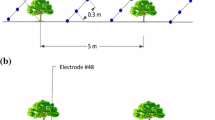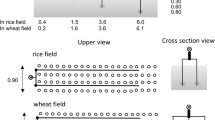Abstract
Soil moisture and suction head in an irrigated orchard were continuously monitored by time domain reflectometry (TDR) probes and gypsum blocks, respectively, during and between successive irrigation events. On each side of the trees in the plot, two 30-cm long probes were installed vertically 10 cm below the soil surface (denoted as shallow) and another two probes were installed vertically 40 cm below the soil surface (denoted as deep). The variation in moisture content measured by the TDR probes between successive irrigation events was qualitatively divided into four stages: the first was during water application; the second initiated when irrigation stopped and the moisture content in the layer sharply decreased, mainly due to free drainage. The succeeding moderate soil-moisture decrease, caused by the simultaneous diminishing free drainage and root uptake, was the third stage. During the fourth stage, moisture depletion from the layer was solely by root uptake. The slopes of moisture content variation with time throughout this stage enabled the monitoring of water availability to the plant. The range of moisture content variations and moisture depletion rates between subsequent irrigation events was higher in the shallow (10–40 cm) than in the deeper (40–70 cm) layer. Irrigation nonuniformity and spatial variability of soil hydraulic properties contributed to the unevenness of the moisture distribution in the soil profile. However, as soon as moisture content within a layer reached field capacity, namely the free drainage had stopped, irrigation uniformity had a negligible effect on water flux to the plant roots. The measured data indicate that soil moisture is fully available to the plant as long as the momentary moisture flux from the soil bulk to the soil–root interface can replenish the moisture being depleted to supply, under non-stressed conditions, the atmospheric water demand. This flux is dominated by the local momentary value of the soil's bulk hydraulic conductivity, K r, and it stays constant for a certain range of K r values, controlled by the increasing root suction. A decrease in water availability to the plant appears for longer irrigation intervals as a break in the constant soil-moisture depletion rate during stage 4. This break is better correlated to a threshold K r value than to threshold values of moisture content or suction. Therefore, it is suggested that moisture content or suction used to measure water availability or to control irrigation first be alibrated by K r(θ) or K r(ψ) curves, respectively.
Similar content being viewed by others
References
Aylmore L A J 1993 Use of computer-assisted tomography in studying water movement around plant roots. Adv. Agron. 49,1–54.
Armstrong C F, Ligon J T and Thomson S J 1985 Calibration of Watermark model 200 soil moisture sensor. ASAE Paper 85,2077.
Baker J M and Allmaras R R 1990 System for automating and multiplexing soil moisture measurement by time-domain reflectometry. Soil Sci. Soc. Am. J. 54, 1–6.
Cassel D K, Kachanoski R G and Topp G C 1994 Practical considerations for using a TDR cable tester. Soil Technol. 7, 113–126.
Carsel R F and Parrish R S 1988 Developing joint probability distributions of soil water retention characteristics. Water Resour. Res. 24, 755–769.
Castle W S 1978 Citrus root systems: their structure, function, growth, and relationship to tree performance. Proc. Int. Soc. Citricult. 62–69.
Clothier B E and Green S R 1997 Roots: the big movers of water and chemicals in soil. Soil Sci. 162, 534–543.
Dalton F N and van Genuchten M T 1986 The time-domain reflectometry method for measuring soil water content and salinity. Geoderma 38, 237–250.
de Jong R and Bootsma A 1996 Review of recent developments in soil water simulation models. Can. J. Soil Sci. 76, 263–273.
Gardner WR 1960 Dynamic aspects of water availablility to plants. Soil Sci. 80(2), 63–73.
Gardner WR 1964 Relation of root distribution to water uptake and availability. Agronomy J. 56, 41–45.
Green S R and Clothier B E 1999 The root zone dynamics of water uptake by a mature apple tree. Plant Soil. 206, 61–77.
Heimonvaara TJ and Bouten W 1990 A computer-controlled 36-channel Time Domain Reflectometry system for monitoring soil water contents. Water Resour. Res. 6, 2311–2316.
Herkelrath WN, Hamburg S P and Murphy F 1991 Automatic, realtime monitoring of soil moisture in a remote field area with time domain reflectometry. Water Resour. Res. 27, 857–864.
Kage H and Ehlers W 1996 Does transport of water to roots limit water uptake of field crops?. Z. Pflanzenernaur. Bodenk. 159–590.
Lascano R J and van Bavel C H M 1984 Root water uptake and soil water distribution:test of an available concept. Soil Sci. Soc. Am. J. 48, 233–36.
Ledieu J, Ridder P, Clerck P and Dautrebande S 1986 A method of measuring soil moisture by time-domain reflectometry. J. Hydrol. 88, 319–328.
Lowery B, Datiri B C and Andraski B J 1986 An electrical readout system for tensiometers. Soil Sci. Soc. Am. J. 50, 494–496.
Molz F 1981 Models of water transport in soil-plant systems: A review. Water Resour. Res. 17, 1245-1260.
Moreshet S, Cohen Y and Fuchs M 1983 Response of mature Shamouti orange trees to irrigation of different soil volumes at similar levels of available water. Irrigation Sci. 3, 223–236.
Noborio K 1996 Measurements of cumulative infiltration and wetting front location by time domain reflectometry. Soil Sci. 161, 480–482.
Shalhevet J and Levy Y 1990 Citrus trees. In Irrigation of agricultural crops. Ed. B.A. Stewart and D.R. Nielsen pp. 951–986. ASA, SSSA, Madison, WI.
Thomson S J and Armstrong C F 1987 Calibration of theWatermark model 200 soil moisture sensor. ASAE 3, 186–189.
Topp G C and Davis J L 1985 Time-domain reflectometry (TDR) and its application to irrigation scheduling. Adv. Irrigation 3, 107–127.
Topp G C, Davis J L and Annan A P 1980 Electromagnetic determination of soil water content: measurements in coaxial transmission lines. Water Resour. Res. 16, 574–582.
van Genuchten M T 1980 A closed-form equation for predicting the hydraulic conductivity of unsaturated soils. Soil Sci. Soc. Am. J.44, 892–898.
van Wesenbeeck I J and Kachanoski R G 1988 Spatial and temporal distribution of soil water in the tilled layer under a corn crop. Soil Sci. Soc. Am. J. 52, 363–368.
Zegelin S J, White I and Jenkins D R 1989 Improved field probes for soil water content and electrical conductivity measurement using time domain reflectometry. Water Resour. Res. 25, 2367–2376.
Zhang M, Alva A K, Li Y C and Calvert D V 1996 Root distribution of grapefruit under dry granular broadcast vs. fertigation method. Plant Soil 183, 79–84.
Author information
Authors and Affiliations
Rights and permissions
About this article
Cite this article
Polak, A., Wallach, R. Analysis of soil moisture variations in an irrigated orchard root zone. Plant and Soil 233, 145–159 (2001). https://doi.org/10.1023/A:1010351101314
Issue Date:
DOI: https://doi.org/10.1023/A:1010351101314




